A light rain patters against the hotel room window, muffling a smattering of fireworks and occasional dull thunder rumbling in the distance. The weather front moving through Charleston, South Carolina, is dampening the local holiday celebrations. I’m staring at my watch as it turns midnight. My beautiful bride, Kareen, is fast asleep. She’s an extreme morning person. I’ve never seen someone with more natural energy at 4:00 a.m. It’s sacrilegious to night owls like me. After dinner, the countdown begins on her nightly transformation into a pumpkin. Her hibernation is usually underway by 8:00 p.m. Kareen’s dead to the world on this New Year’s Eve. I’ve never seen her awake at midnight on New Year’s Eve. I nudge her at 12:01 a.m. She mumbles, “Is it twenty-whatever?” and rolls over.
“Yes, it’s twenty-whatever.” Before my reply is finished, her slow and steady breathing announces a return to unconsciousness.
She will start a movie on her computer and watch less than five minutes before fading away. Whatever she’s started will keep playing until I come to bed and close her laptop, only to have her awaken and mumble, “I was watching it.”
My standard reply: “Yeah, I can see that.” She’s notorious for watching the same ten minutes of a show over and over. It’s like watching Sisyphus roll the stone up the mountain. Her computer’s silent on December 31, 2015. And I’m up alone, lost in thought. The subtle background noises fail to break a deafening silence.
I’m restless. My excited mind moves from one destination to the next, reviewing the new year’s calendar month to month. I’ve been thinking about the new year with greater frequency for six months. This new year is special. It’s the start of the National Park Service’s centennial anniversary. I hope to visit as many parks as possible in 2016, beyond progress on the goal to see all the NPS units. The challenge enhances the normal excitement I’ve felt planning visits to new sites over the past few years. This year, the parks dominate. In that spirit, a few months ago I told Kareen, “I’m leaving my job after my twentieth service anniversary in early February 2016 and spending the year in the parks. Whatever and whenever my next job might be, it can wait until 2017.”
Kareen and I are both professionals with a modest standard of living. When we met in July 2010, at ages forty-one and thirty-nine, the decision point to have children had come and gone. That’s okay with us. Neither of us feels the burning drive that moves others to procreate. As a result, we have more options than most couples our age. I can entertain plans to hit the road. The personal factors aren’t prohibitive. The enormity of the task is the issue. I’ve already been to over three hundred of the more than four hundred parks in the National Park System. What I’m contemplating tonight is visiting as many in one year as I’ve visited lifetime to date. Just thinking about it is tiring. It’s also exciting. I’m ready to see what I can do. Untold thrills and new adventures await.
Kareen talked me out of leaving my job in 2016, pointing out that, with the nature of my work and my low internal visibility, I can fulfill work obligations and visit parks simultaneously. Her initial concern had been that I might drift without the job. She came to realize that I have too much energy and passion to languish in despair. We’ll be okay. I concurred, delaying any career change, and shifted to planning the year with the continuing restriction of a full-time job. I’m reconciling the situation and what it portends when we arrive in Charleston. I’m blissfully ignorant that I’m about to embark on a quest that will challenge the limits of my physical and mental endurance in a twelve-month test of passion against stamina.
Our 2016 New Year’s Day in Charleston is our second consecutive New Year’s Day in South Carolina. The winter trips south are mutually agreeable. I’m trying to familiarize Kareen with southern cities, hoping we’ll move farther south. In recent years, each winter feels colder and more uncomfortable than the last. We both appreciate a break in the monotony of Chicago’s long winters. I thrive on outdoor recreation and the chance to explore. Long winters thwart these basic needs. Moreover, a change extracts us from a corrupt, failed state government, and Kareen’s medical practice, in much the same condition. Most importantly, a joint move will finally consolidate our homes and lives.
Our circumstances led to separate homes ninety miles apart. Her condominium in Chicago’s Lakeview neighborhood is too small for both of us to occupy full-time as an exclusive residence and doesn’t allow pets to even visit, precluding the two Labrador retrievers I had when we met. My house in Rockford is much too far away for her to commute. She regularly works twelve consecutive days since she works twenty-four weekends each year. When we met, Kareen’s US travel experience wanted. After her residency in Washington, DC, and first three years as a practicing nephrologist in the underserved community of Decatur, Illinois, a requirement for her H-1 visa and permanent US residency, she moved to Chicago on her first day of eligibility. She felt isolated and starved for cultural stimulation in Decatur. Since we got engaged, I tried suggesting other places in the country for a home together. Kareen rejected each location without any real knowledge of it. I sympathized, grasping the difficulty and loneliness for her starting life anew in a small midwestern town. I felt similarly misplaced when my company moved me to Elkhart, Indiana, for three years in 1999. The area never felt like home. I gained ground with Kareen on our first trip to Charleston. She loved the city. I promised her that the beautiful historic homes, great cuisine, and mild climate fuse into a unique experience. But she’s naturally resistant to change in a life built around routine.
Her career began draining her vitality away before we met. She works sixty-hour weeks and almost half her weekends and holidays. An uneven work distribution pervades within the practice, sometimes to extremes. The clinic staff, knowing some pages go unanswered, often call Kareen for other doctors’ patients. Contractual obligations are selectively enforced or ignored. The entity moves on inertia, absent of management or strategy. The constant strain debilitates Kareen and affects our marriage. I watch her grow weaker under the workload and stress. We don’t need this burden and cannot survive under it indefinitely. Mostly, I’m concerned about her health. Yet, she resists change. I couldn’t understand why for the longest time.
Kareen’s major life ambition included US citizenship and a dynamic medical practice in a diverse urban setting. She’s achieved her goal and wants to maintain it. But at what cost? Something in her mind views leaving the practice as a personal failure. The stress and negativity is a price she’s been willing to pay, literally the frog in boiling water. Every time she experiences some unethical or nasty thing at work, she vents her rage at me, not to me, avoiding professional confrontation. It’s left a cumulative set of scars. As I’m sitting in the silence of the new year, watching raindrops hit the glass, I can only speculate on the extent to which Kareen’s toxic work environment will affect us in 2016.
New Year’s Day, we walk two miles east from our hotel to Liberty Square, the visitor center and departure point for Fort Sumter. Kareen and I visited Fort Sumter National Monument a year ago, though the park’s closed today. The isolated brick guardian of Charleston’s harbor gained permanent fame at 4:30 AM on April 12, 1861, as the recipient of the Civil War’s opening salvo. On our boat ride, we left a beautiful, sunny, sixty-degree day in Charleston only to find an isolated dark cloud hanging over the outer harbor and island fort. We could see rain falling on the structure as we approached the dock. It rained for the first forty-five minutes of the hour-long tour. This day marked my third visit to the island. The rain confined us to sheltered areas like the fort’s museum. We studied the Palmetto flag raised by victorious southern troops after Union forces commanded by Major Robert Anderson surrendered the fort on April 14, 1861. The action created the Civil War’s first two military heroes: Major Anderson in the North for his gallant defense of the besieged fort without reinforcement or resupply, and Brigadier General Pierre G. T. Beauregard in the South for his command of the forces that evicted the hated Yankees from Charleston Harbor. Beauregard would become the first Confederate promoted to the rank of full general. The fort’s capitulation gained control of the important southern port for the Confederate States of America.
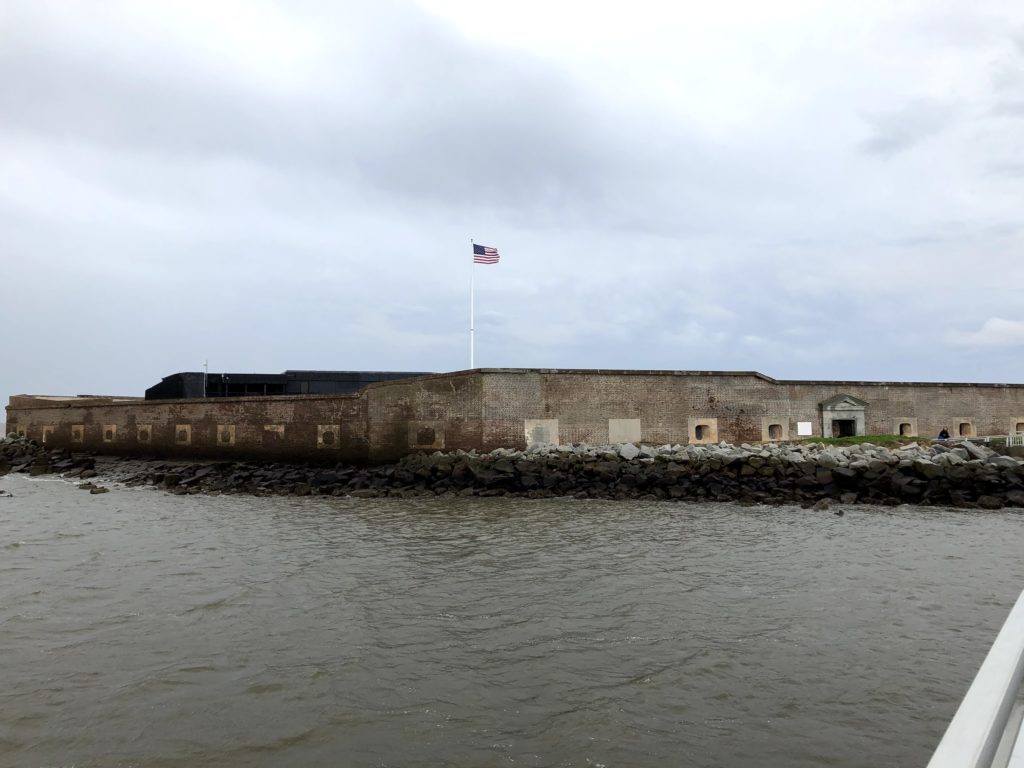
Fort Sumter from the boat
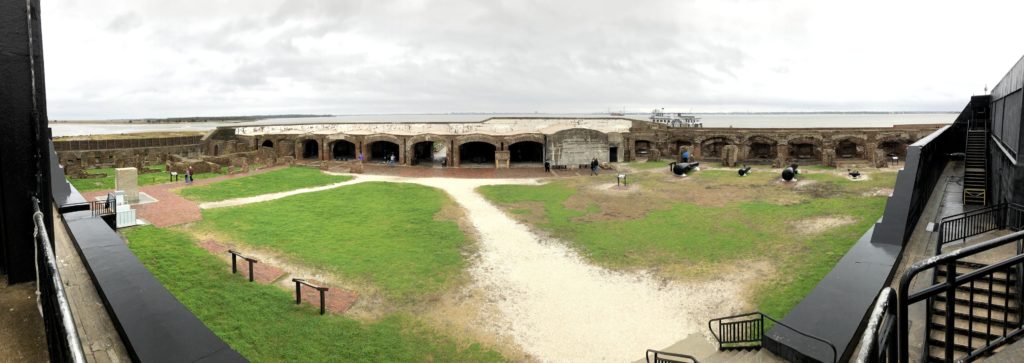
New Year’s Day 2016 consists of touring Charleston Aquarium at Liberty Square, followed by a midafternoon meal at a seafood house in old Charleston. The next morning, we return prepared to revisit Fort Sumter. At the Liberty Square Visitor Center, we examine part of the thirty-three-star American flag flown above the fort during the bombardment. Only a small section is displayed at any one time to minimize fabric degradation.
Hoping to collect the fort’s centennial cancellation, we change plans when we learn they don’t yet have one. We decide to spend our time at Fort Moultrie on Sullivan’s Island. Enjoying sunny skies and a cool breeze, we stroll through the grounds and amuse ourselves with a picture of Kareen looking down the barrel of one of the cannons lined up on exhibit beside the fort. As an active military post for 171 years from the American Revolution through World War II, Fort Moultrie is an excellent example of US coastal defense evolution. The original structure consisted of two palmetto-log walls bracketing earthen fill. The soft, spongy palmetto wood absorbed the shot from the British navy’s smoothbore cannon during the bombardment on June 28, 1776, allowing the fort’s thirty guns to drive off the two-hundred-gun British fleet. The British didn’t make the same mistake twice, avoiding the fort when they captured Charleston as part of Cornwallis’s southern campaign in 1780–81.
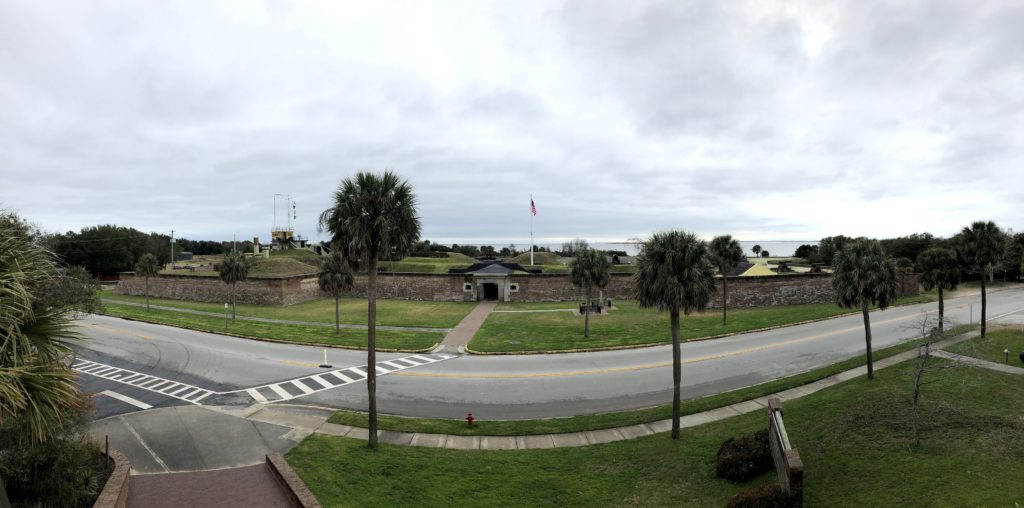
Fort Moultrie from atop the adjacent visitor center
Our next stop is Charleston’s other NPS unit, Charles Pinckney National Historic Site. The unit preserves the surviving 28 acres of Snee Farm, originally part of 715 acres Charles inherited from his father in 1782. The Pinckney’s owned the plantation for over sixty years, selling it in 1817. None of the structures built during the family’s era remain. The surviving home sits on the foundation of the original Pinckney plantation house and dates to the late 1820s, after Pinckney’s 1824 death. Pinckney served as a delegate and signer at the 1787 Constitutional Convention. His ideas for reforming weaknesses in the Articles of Confederation influenced the US Constitution.
We warm ourselves in the sun as we follow the trail around the tidewater cottage, reading about plantation life in the late 1700s and early 1800s. Pinckney regarded Snee Farm as a favorite among his seven plantations, though he made his primary residence in a Charleston townhouse. Many of his papers burned in the Charleston fire of 1861. Most of what is known about the farm during Pinckney’s lifetime is based on archeological evidence.
Charles Pinckney National Historic Site and the other coastal park units, extending from Wilmington to Jacksonville, are part of the Gullah Geechee Cultural Heritage Corridor, which celebrates the culture and language of the formerly enslaved who gathered in nineteenth-century barrier island communities. Both names have, in turn, been used to describe the African descendants living in these communities and their English-based creole language. Gullah represents a blend of British, American, and West African culture, food, religion, and traditions, including the creole language spoken in these communities. Geechee generally describes African Americans living on the Atlantic Coast of South Carolina, Georgia, and northern Florida. The island community culture has direct connections to the West African Coast. Many of the sea islands were only accessible by boat in the nineteenth century. The relative isolation helped preserve African linguistic and cultural heritage among the Geechee to a greater extent than for any other African American community in the United States.
At least forty major African coastal slave castles served the slave trade in the eighteenth and nineteenth centuries, though the Geechee are most closely connected to Bunce Island. Englishmen owned the Bunce Island slave castle, and the majority of the enslaved leaving the island ended up in the West Indies and North America. Overall, during the African slave trade, only 4 percent of enslaved Africans were brought to North America, compared to the 96 percent destined for Brazil and the Caribbean.
Traders operating out of Liverpool, Bristol, London, and Newport, Rhode Island, carried their human cargo from Bunce Island during its period of English control, from 1670 until Great Britain banned the trade in 1807. Located twenty-five miles up the Sierra Leone River, feeding the largest natural harbor on the West African Coast, the island survived four French attacks from 1695 to 1794—two by pirates led by Bartholomew Roberts (more famously known as Black Bart) in 1719 and 1720.
Bunce Island lies at the furthest point of navigation for oceangoing sailing vessels on the Sierra Leone River. Traders operating the fortress extracted captives from outposts stretching over six hundred miles, from Senegal and Gambia in the north to Sierra Leone and Liberia in the south.
Enslaved workers brought to the South Carolina coast important knowledge of rice cultivation previously unknown to English planters, such as the tidal flow method to power rice irrigation. Henry Laurens, who succeeded John Hancock as president of the Continental Congress, served as one of the United States’ three representatives for the 1783 Treaty of Paris, ending the Revolutionary War. Laurens, one of the wealthiest plantation owners in South Carolina, functioned as the largest agent for Bunce Island trade in the southern American colonies. The principle owner of Bunce Island, Richard Oswald, represented England as one of his counterparts.
With a few hours left in our day, we take advantage of Kareen’s first opportunity to see Savannah, Georgia, 120 miles south. Kareen doesn’t want to spend four hours on the road, preferring a relaxed agenda. She relents at the promise of a delicious meal in Savannah. My idea seems a catastrophic error as mile after mile of bumper-to-bumper traffic crawls north on I-95. The solid mass continues with few interruptions most of the way to the Savannah exit. Choked with East Coasters returning home after spending the holiday week in Florida, I shudder to think of the hundreds of miles remaining for these travelers. Looks like we’ll be taking another route back to Charleston. Fortunately, the lighter southbound traffic doesn’t impede us, leaving time to tour Fort Pulaski National Monument.
James Madison authorized Fort Pulaski. Built from 1829 to 1847, it still awaited full armament and a garrison when tensions rose between the states in late 1860. Then Georgia governor Joseph Brown seized the fort without a fight on January 3, 1861. An imposing structure, the pentagonal fort has seven-and-a-half-foot thick brick walls surrounded by a forty-foot wide moat. A triangular demilune built outside the gorge, or back wall, after the Civil War connects the fort and surrounding land via a drawbridge and appears as several earthen mounds protecting magazines and passageways between gun emplacements. Both military leaders of the time and Savannah-area residents considered the fort impregnable. The fortification commanded Cockspur Island’s swampy landscape, controlling the Savannah River channel between the key southern port and coastal shipping lanes.
After launching a southern Atlantic coast campaign in late 1861, the Union retook the fort. The decisive thirty-hour bombardment beginning on April 10, 1862, inflicted heavy damage from the use of a new military innovation, the rifled cannon. As we walk around the southeast corner of the fort, I show Kareen the massive hole blown through this corner by artillery positioned a mile away on Tybee Island. The damage shows in color variation between original and replacement bricks. Passing the moat’s eastern side reveals round and cylindrical projectiles imbedded in the brick. The success at Fort Pulaski marks a major turning point in military strategy and defense. Typical smoothbore cannons of the period had an effective range under a half mile and were virtually useless in attack of strong defensive positions farther out. Rifling a gun barrel dramatically increases the effective range and punching power for artillery and small arms alike. Rifled artillery not only reduced Fort Pulaski but made brick and mortar forts obsolete. The same innovation in small arms made an equally profound impact on Civil War infantry combat.
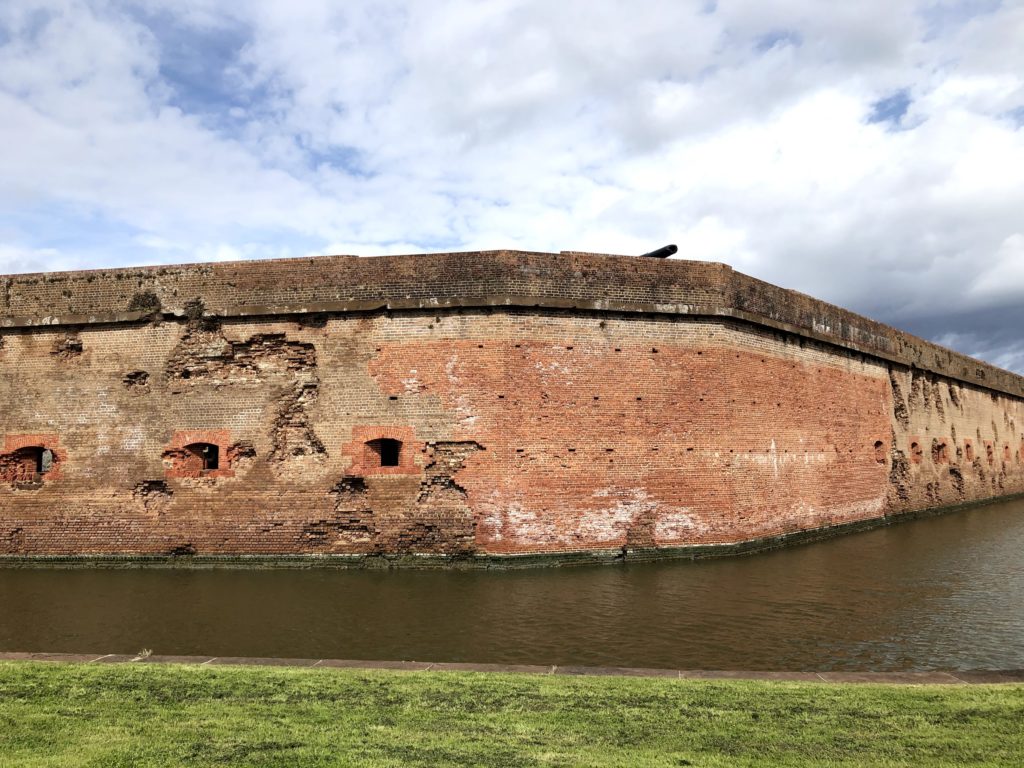
Fort Pulaski’s battered corner, the section destroyed and later repaired by occupying Union troops remains visible today.
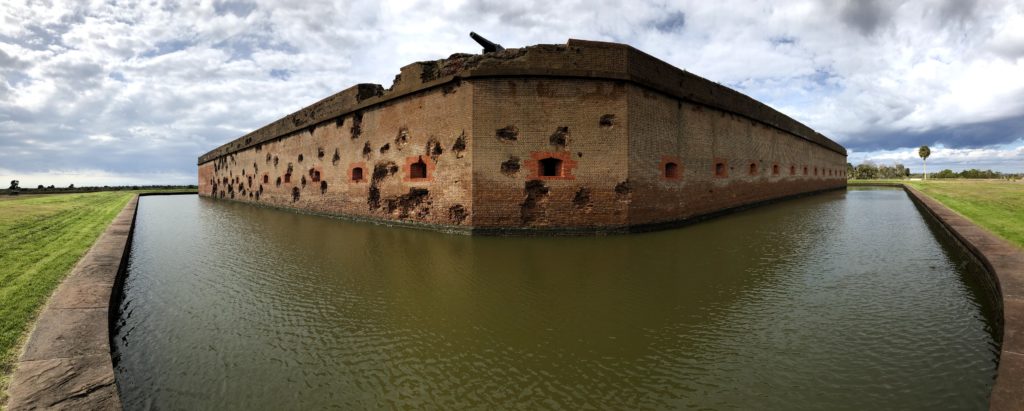
Damage from the April 10, 1862 bombardment can be seen by present-day visitors. The effectiveness of rifled artillery against brick fortifications marked a major development in military science.
Though the Union’s capture of Fort Pulaski limited commercial traffic to Savannah, blockade runners could still reach the port while friendly forces controlled the inland waterways. The Union did not attain total control over Savannah until Sherman’s March to the Sea ended here in December 1864. Sherman closed the march by penning his famous telegram to President Lincoln, offering the town as a Christmas present.
Across the parking lot from the fort, a trail leads to the site of the fort’s former supply dock. A spur trail reveals another interesting piece of history within the park, commemorated on a brick column called the Wesley Monument. John and Charles Wesley made landfall on Cockspur Island, first setting foot on North American soil in February 1736. John remained in Savannah, while Charles continued farther south on the Georgia coast to the town of Frederica. The missionary expedition ended unceremoniously for both Wesley brothers. Charles returned home from Frederica in May 1736, and John followed in December 1737 after what amounts to a case of jilted love. John Wesley recovered from his misadventures to establish the modern Methodist Church. Charles nicely summarized his feelings about Georgia with the statement, “I was overjoyed at my deliverance out of this furnace . . .” He is remembered today as the writer of over six thousand Christian hymns, some of which remain popular. I love the Wesley story for how it humanizes the brothers as men with ordinary weaknesses long before their historical status as religious icons.
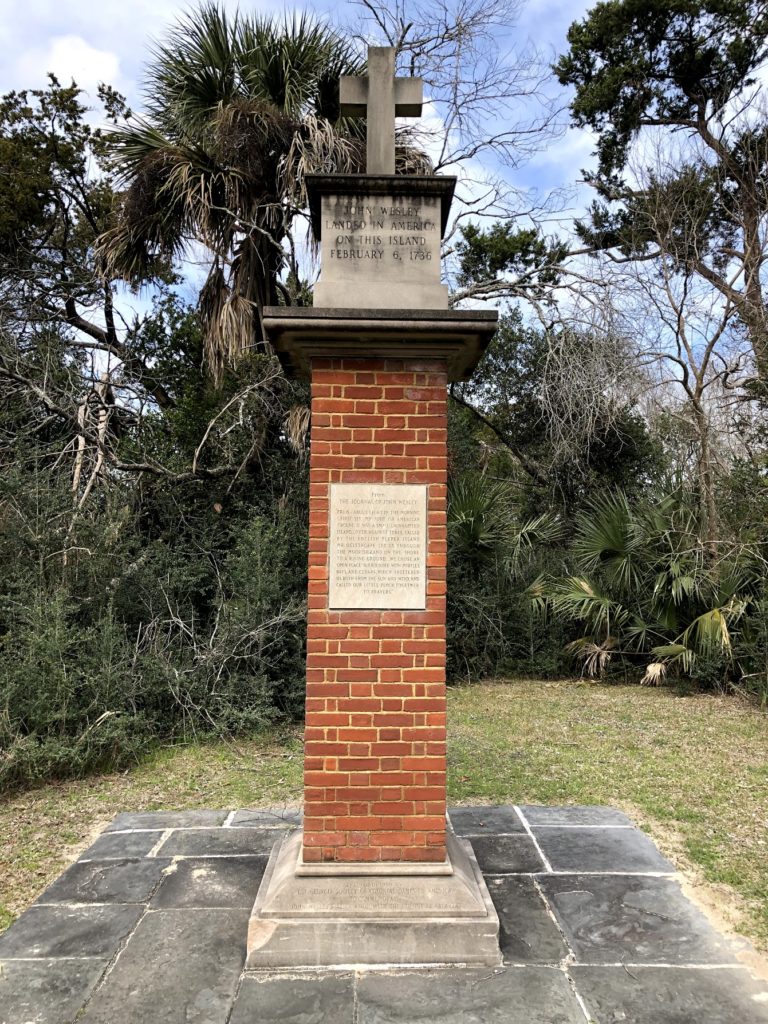
Wesley Monument
Ready for dinner, we stop at the Pirates’ House Restaurant in Savannah. The building dates to 1753 and has quite a history. A dark passage, now behind protective bars, appears to our left as we’re led to our table in a newer dining area. According to legend, unsuspecting tavern-goers would be encouraged to drink to intoxication and, when incapacitated, would be carried through this waterfront tunnel to a waiting ship on which they would wake up the next morning well out to sea. Given the colonial history of press gangs, it’s possible such stories have basis in fact. “Efficient concept,” Kareen notes. We survive an excellent seafood feast without being pressed into service. The return to Charleston by the alternate coastal route gets us back to our hotel room in time for a blissful rest.
After returning to Chicago, I have a week to catch up on life before the next park visit, this one close to home. The following Sunday, January 10, in bone-numbing cold at two degrees, I roll up and down the hills of southwestern Wisconsin’s “Driftless Zone,” named as such because the glaciers that flattened much of the upper Midwest during the last ice age ten thousand years ago did not cover this area. The glaciers bypassed southwestern Wisconsin but continued south, leveling much of Illinois into the prairie that gave the state its nickname.
Today marks the first of more than 350 parks I’ll visit solo throughout the year. I miss Kareen’s company. The excitement of park exploration combats loneliness, but today’s frigid temperatures curtail any impulse to hike. An upside of solo travel will be the countless books on tape I’ll enjoy while logging over eighteen hundred hours of windshield time this year.
Today’s destination lies on the Mississippi River bluffs north of Harper’s Ferry, Iowa, and across from Prairie du Chien, Wisconsin. Effigy Mounds National Monument splits into a north and south unit. The more frequently visited north unit’s main trail starts behind the visitor center. I walked the north unit trail during my first three visits, enjoying the 850-to-1,400-year-old mounds and views from the high river bluff of eagles bouncing in the air currents only feet away. During my last visit, I explored the south unit’s Marching Bear Mound Group. Many visitors skip the four-mile roundtrip hike from a small parking area along State Highway 76 to the park’s southern boundary and miss this spectacular sequence of well-preserved mounds shaped into ten bears and three birds in flight.
With the bitter cold outside, I enter the theater to watch some park service videos as part of a special film review taking place this weekend. The first film is a documentary on world population growth and its impact on fish populations. Much of the footage features Jamaica. The island’s coastal waters have been overfished in the past half century. Most larger fish have vanished, leaving only immature specimens. I think about our upcoming trip to Jamaica and eating some of those fish. Meanwhile, I’m anxious to schedule more park travel. The cold keeps me off the trails at Effigy Mounds, but it won’t at my next destination in the southern Arizona desert.
